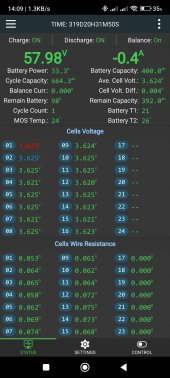Since installing my 8s2p 498ah LiFePO4 setup, I've had recurring issues with so called "runners". By that I mean, 1 or 2 cells in the pack will go to a much higher voltage than the rest of the cells whilst under charge voltage. For instance, when charging my pack to 28.00v, at 27.9v or higher the runner will get to 3.62 or 3.63 volts while the rest of the cells are at 3.4 to 3.5 volts.
This can cause problems with the charge cycle due to BMS shutdown for overvoltage. I have had success "bleeding" off the high cell using a 100 watt 1 ohm power resistor connected to two multimeter needle probes. Bridging the resistor across 1 (or 2) cells will bring down the voltage to get it in-line with the rest of the pack. That will work for 1 or 2 charge cycles but inevitably, that same cell will drift and become a runner again. It always seems to be cells 7 or 8 in the pack, and both of my 8s packs have the same behavior. All cells are well balanced, within .003 volt of each other through their entire cycle, they only become runner's at the end of the charge cycle.
Things I have made sure of:
Top balanced both packs to 3.65v in parallel for several hours prior to wiring in series
Bus bars and terminals scotch-brited and NoOx applied
I have been able to manage by dropping the charge voltage to 27.6v (3.45/cell) but I would like to understand why top-balanced cells that seem to perform so well in every other situation become runners like this, and what if anything I can do about it.
This can cause problems with the charge cycle due to BMS shutdown for overvoltage. I have had success "bleeding" off the high cell using a 100 watt 1 ohm power resistor connected to two multimeter needle probes. Bridging the resistor across 1 (or 2) cells will bring down the voltage to get it in-line with the rest of the pack. That will work for 1 or 2 charge cycles but inevitably, that same cell will drift and become a runner again. It always seems to be cells 7 or 8 in the pack, and both of my 8s packs have the same behavior. All cells are well balanced, within .003 volt of each other through their entire cycle, they only become runner's at the end of the charge cycle.
Things I have made sure of:
Top balanced both packs to 3.65v in parallel for several hours prior to wiring in series
Bus bars and terminals scotch-brited and NoOx applied
I have been able to manage by dropping the charge voltage to 27.6v (3.45/cell) but I would like to understand why top-balanced cells that seem to perform so well in every other situation become runners like this, and what if anything I can do about it.



